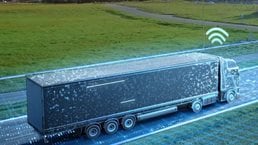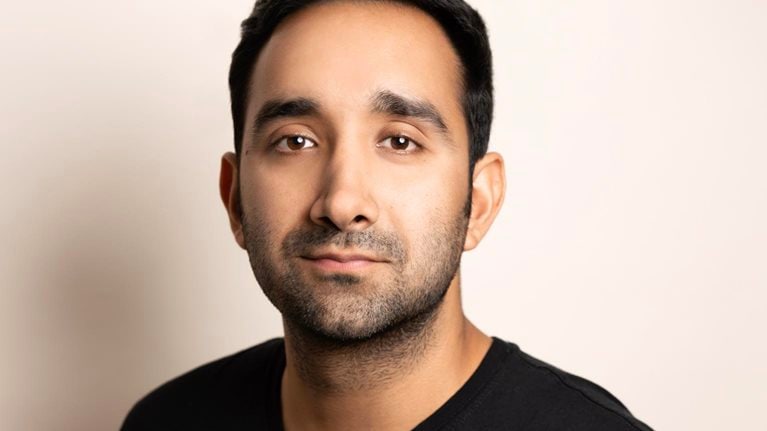In 2013, Shoaib Makani cofounded a start-up that he hoped would make the trucking industry more efficient through digitization. The goal was to give truck drivers and fleet managers better insights into what was happening both within their cabs and across their operations. “We named the company KeepTruckin because it captured the essence of that mission and the people who we wanted to serve,” Makani says. “Drivers loved it.”
KeepTruckin got early backing from investors including Google Ventures. And it scaled up: it now has more than $250 million in annual recurring revenue, with an annualized growth rate of roughly 70 percent.1 But this April, nine years after KeepTruckin’s founding, Makani changed the company’s name to Motive. Why the rebrand?
“We wanted our name to reflect the breadth of problems we solve and the diversity of industries that we serve,” he says. “We didn’t want a name to constrain our potential or how the market receives us.” Translation: the business wasn’t just about trucks anymore.
Motive now serves more than 120,000 organizations, from small companies to Fortune 500 enterprises, across a wide range of industries. A recent funding round valued the San Francisco–based Motive at $2.85 billion. In this installment of Logistics Disruptors, Makani spoke with McKinsey’s Alastair Green about the promise of AI-driven automation, the importance of easy-to-use design, and the notion that culture and people are a company’s only durable competitive advantages.
McKinsey: Why is Motive shifting from a fleet-focused company to a much broader industry offering—including vehicles, equipment, and facilities?
Shoaib Makani: When we started the company, more than nine years ago, our mission was to bring the trucking industry online. We wanted to build technology that would improve the safety and efficiency of the businesses that keep our economy moving.
Along the way, we realized that the problem we solve applies not just to the trucking industry but to really all businesses and organizations that operate in the physical economy—construction, agriculture, field service, manufacturing, energy, and many more. The common thread that runs through all of these industries is the need to connect and automate their physical operations. Without digitization, these businesses cannot efficiently grow to meet what is an ever-increasing demand for their output.
Motive builds technology to improve the safety, productivity, and profitability of businesses that power the physical economy. Our IoT [Internet of Things] hardware connects vehicles, equipment, and facilities to the cloud. And our AI-powered applications automate vehicle and equipment tracking, driver safety, compliance, spend management, maintenance, and more. We combined all of this into our Automated Operations Platform, which gives businesses a holistic view of their operations.
McKinsey: What are today’s customers looking for from operational platforms?
Shoaib Makani: There are really three key areas. Number one is integrated technology. We release hundreds of features and improvements each year to help our customers stay ahead, but we always make sure that those products work together to provide one integrated view of your operations. You can contrast this with the legacy vendors, which really are just point solutions—they solve one, or maybe two, problems. Businesses want one platform that can give them visibility and control across their entire physical operations, and that really defines the work that Motive does.

Logistics Disruptors
Meet the companies shaping how goods will move tomorrow.
Number two is AI-driven automation. We developed machine-learning models with industry-leading accuracy. That allows our customers to automate an expanding set of operational workflows. This is important, given the constraints in the labor market. Labor force participation is declining as our population ages. Demographic shifts are making it challenging to recruit and retain talented employees. The shortage of skilled labor, combined with high employee turnover, leads to less experienced employees and thus lower labor productivity.
For businesses that operate commercial vehicle fleets, this doesn’t have just financial consequences. This has real societal impact. The shortage of qualified drivers translates into more accidents and reduced road safety. By leveraging AI to augment the capabilities of human workers, businesses can unlock massive safety and productivity gains that improve their profitability. This is why we’re investing a significant amount of capital in AI-driven automation. And it’s having a very real impact on our customers. They’re not only realizing productivity gains but they’re also preventing accidents, and actually saving lives, through technology like our AI Dashcam.
And then number three, in terms of customer value, is excellence of design. We build products that are a joy to use. We want to make life easier for our users—from the driver to the CEO and everyone in between. There’s no reason why the technology that is used in physical operations can’t be designed as well and as intentionally as the tech we use in our personal lives.
McKinsey: How will the evolution of technology—things like advanced sensors, blockchain, quantum computing—further reshape Motive’s business?
Shoaib Makani: I think the greatest impact will come from advances in machine learning and AI. A lot of the recent focus has been on autonomous vehicles and automation that replaces the human, particularly in the context of driving. But I think the much more interesting and impactful applications of AI are the ones that augment and extend the capabilities of human work.
A lot of the recent focus has been on automation that replaces the human, particularly in the context of driving. But the much more interesting and impactful applications of AI are the ones that augment and extend the capabilities of human work.
AI can proactively surface safety and compliance risks—inefficiently utilized vehicles and assets, excess or fraudulent spend, and more. And through AI-driven workflow automation, you can programmatically schedule real-time interventions that can be taken on behalf of human managers. That reduces cost but actually improves operational performance.
For drivers, AI can prevent accidents by alerting them of unsafe driving behaviors such as cell phone use, distraction, and close following. The result of this is lower insurance costs for businesses and safer roads for everyone else. This is why we’re investing so aggressively on the AI side. The consequence of success here is absolutely massive.
Take the example of AI-powered dashcams. There is up to ten times ROI on this technology. It is clear when you deploy them that you reduce accidents. You save on insurance cost. And if you aren’t deploying that technology, while your competitors are, you’re at a structural disadvantage.
McKinsey: How have you approached customer experience?
Shoaib Makani: I’ll point to our AI Dashcam. It’s a beautiful piece of hardware. Looks great in the vehicle itself. But it also is exceptional from a driver experience perspective. It’s out of the way when you don’t need it. But when there is unsafe behavior, either ahead of you or inside the cab, it alerts you with subtle visual and auditory cues. It actually helps you correct your behavior without getting in your way.
And central to that is high precision. Which means few false positives. You as a driver don’t want to be interrupted if you’re not doing something unsafe. That fundamentally impacts the usability of our product.
Another great example is Fleet View, which is a visual experience for our fleet managers so that they get a really universal view of their vehicles, their equipment, their assets, their drivers, all in one place. It’s incredibly easy to navigate and one unified experience across their entire operations.
McKinsey: What is your ambition for Motive’s growth over the next five years? And how are you going to accomplish that?
Shoaib Makani: It starts with the customer. We are at the core a customer-centric company. We seek to deeply understand the problems our customers face and solve them in the highest-quality way possible. And thankfully, we have great customers who partner closely with us to build the technology of the future.
Given the scale of the problems we solve and the broad range of industries we serve, our total addressable market is huge—well north of $50 billion and growing rapidly, as we launch new products and expand into new geographies.
To be specific, there are three primary areas of focus and investment for the business over the next … let’s call it five years. Number one is fleet management. This is our core business today—building IoT hardware and AI-powered applications that automate vehicle and equipment tracking, driver safety, compliance, maintenance, and a whole lot more. There’s still so much more value we can deliver for our customers here, and we are investing aggressively to do so.
Number two is spend management. We recently launched the Motive Card, which is the first corporate card integrated natively with a fleet management platform. It gives our customers powerful controls that allow them to reduce excess spend and actually eliminate fraud. We’re just a few months into the launch of the Motive Card, but the growth has been absolutely exceptional.
And then number three is physical security. Our customers depend on us to monitor the safety and security of their vehicles and physical equipment. And now they want us to help them manage the security of their physical spaces—their facilities, their warehouses, construction sites, and a whole lot more. We built a deep competency in developing AI-powered cameras for vehicular applications with our AI Dashcam. And now we’re taking that expertise and applying it to physical security. We’ll be releasing the first version of our AI site cam in 2023.
The combination of these three—fleet management, spend management, and physical security—is going to keep us busy for many years to come. And I think it will allow us to compound and grow the company at a very high rate well into the future.
McKinsey: We’ve heard from some of the other interviewees in this series that logistics in physical industries are very relationship-based and not always at the forefront of digital innovation. So how do you think about attracting the right kind of talent to Motive and getting folks to come to you instead of others?
Shoaib Makani: We have always taken the view that there are great people all over the world. And we seek them out. We don’t wait for them to arrive. We’re very intentional about the kind of people we’re bringing to the company. We are explicit about our operating principles and the values that we reward.
Number one, ownership. We want people who really own the problem no matter what their function and advocate for the customer in doing so.
Number two, we want people who reduce complexity. “Less but better” is one of our key operating principles. We want to reduce complexity internally as an organization and also for our customers.
Number three is building trust. We want to make sure that we’re bringing in people who want to work together to solve common problems. And the only way you can do that is by building trust with your peers.
And then fourth, it’s all about unlocking potential. We want to make sure that the people who we bring into the company want to make the people around them better. Those four operating principles guide how we think about talent recruiting and retention and inform how we think about developing our next generation of leaders in the company.
To answer your question around how do we compete with other technology companies, ultimately the people who come to Motive are the ones who want to operate at scale and have real-world impact. We’re talking about physical problems in the physical world that we solve. But these are also people who want to move incredibly quickly. Despite now being an organization of almost 3,500 people, we pride ourselves on the speed with which we innovate. We’re not going to let that go.
McKinsey: How does Motive use its cloud-based platform to serve and empower small and medium businesses [SMBs]?
Shoaib Makani: At Motive, we take real pride in serving businesses of all sizes, from small companies all the way to Fortune 500 enterprises. The problem we solve is universal. Any business that operates commercial vehicles—physical equipment, physical assets—can improve the safety, productivity, and profitability of its operations with our technology.
SMBs generally have lower rates of technology adoption. That puts them at a competitive disadvantage relative to their larger peers. But it’s not their fault. The legacy technology in this market has really let businesses down. There was no integrated platform that can solve the broad range of operational problems that businesses deal with, all in one place. You would need one vendor for tracking vehicles, another for compliance, another for dashcams, another for fuel cards.
SMBs generally have lower rates of technology adoption. That puts them at a competitive disadvantage relative to their larger peers. But it’s not their fault. The legacy technology in this market has really let businesses down.
By bringing all of this into one integrated platform, we reduce the total cost of ownership. And most important, we give our customers one holistic view of their operations. We eliminate those data silos. That is of particular value for SMBs. They simply don’t have the resources to pay for and manage many different vendors.
McKinsey: What keeps you up at night as a CEO?
Shoaib Makani: I think this has evolved over time. But the thing that’s top of mind for me now, and more than ever, is our ability to continue to attract the right people to the company and give them the platform to do their best work. I believe that the only durable source of competitive advantage is a company’s culture and its people. Every technology, no matter how dominant it may be, will eventually be obviated or replaced by something better. It’s just a matter of time.
If I want to build a generational company, if Motive is going to last into the future, we have to keep innovating. We have to keep solving new problems and building the technology of the future. That means we need the absolute best people enabled with the right operating principles to execute. That’s what I think about more than anything.

